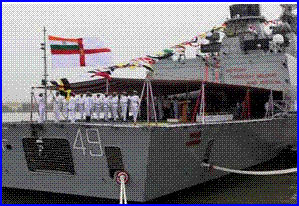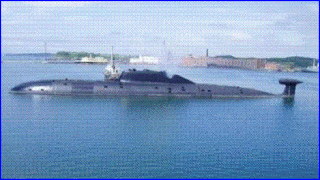By
Jennifer McArdle
India’s Navy has for too long been neglected when money
has been allocated. The latest defense budget suggests that may be starting to
change.
In comparison with its sister services, the Indian Navy,
or India’s “Cinderella service,” since independence,
has consistently garnered the paltriest share of the defense budget. However,
the release of the 2012-2013 defense budget, allocating the Navy the lion’s
share of the capital budget in comparison to its sister services, seems to
suggest otherwise. Has India’s “Cinderella service”
finally found its glass slipper?
After the withdrawal of the British in 1947, and its
subsequent partition, India has perpetually grappled with various forces of
endogenous unrest. From the long-standing insurgency struggle in India’s
northeast, to the slow-burning conflict waged against the Naxalite movement in
large swathes of its interior, to the separatist struggles in Punjab and
Kashmir, the Indian state has found itself compelled to deploy a
large number of ground troops in order to maintain a unified state.
India’s inward-looking security mindset was further
solidified during the 1962 Sino-Indian conflict, as Indian troops were overrun
by a lightening Chinese assault across the freezing plateaus of Ladakh and the
mountain passes of India’s northeast. New Delhi’s embarrassment at its lack of
preparedness in 1962, when coupled with the simmering tensions along the
Pakistani border, assured the Army and Air Force positions of relative
inter-service strength. Indeed, the Indian Navy’s share of the defense budget
in 2011 hovered at 15 percent in comparison to the Army and Air force’s shares
of 51 percent and 28 percent, respectively.
Unlike past budgets, the Navy is the only service to
increase its share of total defense allocation – up to $4.77 billion from $2.74
billion last year.
The Army’s budget at approximately Rs. 97,302.54 crore
($19.46 billion) accounts for 50 percent of the defense budget, followed by the
Air Force with Rs. 48,191.16 crore or 25 percent and the Navy at 37,314.44
crore or 19 percent.
While the Army’s share of the defense budget is eaten
away in revenue expenditure, or allowance for the armed forces, the Navy’s
spending is primarily driven by capital expenditure, which is spent on the modernization of the naval armed
forces. The Navy received a 72 percent hike in its modernization budget, in
comparison to its sister services at +0.5 percent in the Air Force and -3
percent in the Army. The hike in the Navy’s budget allows it to boost spending by 74 percent in the next
financial year.
The upswing in spending doesn’t necessarily amount to a
long-term prioritization of the Indian Navy over its sister services. Much of
the new spending allocated to the Navy will be used to pay off previously
acquired naval platforms, platforms which have become increasingly expensive
with the depreciation of the rupee and constant price renegotiations.
As noted by Defense News, last year, after a series of
cost discussions and setbacks with the Russians, an agreement was finally made
for an extra $1.6 billion for the Russia aircraft carrier Admiral Gorshkov,
originally priced at $2.6 billion. Furthermore, as prices of raw materials
rise, particularly steel from Russia, indigenous production has seen a
substantial increase in program cost.
The French Scorpene submarine program at the state-run
Mazagon Dock Limited has seen an increase of $1 billion. Additionally, 46 new
warships are currently underway in Indian naval shipyards including three
destroyers at MDL priced at $3.5 billion and four corvettes at the state-run
Garden Reach Shipbuilders and Engineers (GRSE) for about $2.2 billion.
Yet while New Delhi’s traditional “sea blindness” may appear to be
dissipating, a historical continentalist bias still permeates the Indian
bureaucracy. The Indian Ocean remains largely absent in official Indian
national security policies, despite the best efforts of former naval officers
to articulate the necessity of including the
Indian Ocean in larger strategic thinking.
India’s ability to forestall a looming “Hormuz dilemma,” secure energy resources, maintain
soft power within the Indian Ocean region, and preempt interstate conflict is
partially dependent on the Indian Navy assuming a position of equal
inter-service strength. However, in order for such a change to happen, there
needs to be larger reforms that foster a healthier civil-military dynamic.
The recent sensationalistic reports of a military
coup highlight how detached New Delhi’s civilian leadership has become from the
military. It’s unlikely that a bloated, overextended, historically distrustful
bureaucracy will give the military greater autonomy. Without the capacity to effectively
operate and quickly purchase the necessary acquisitions for modernization, it’s
unlikely the Indian military, and more precisely the Indian Navy, will achieve
the pan-oceanic, blue-water navy that India’s Maritime Military Strategy
staunchly advocates.
Does the Navy’s greater share in defense allocation
suggest a tilt towards the sea by a historically “inward-looking” New Delhi
bureaucracy? It’s too early to say that that the 2012-2013 defense budget
allocation signals an enduring re-balancing towards the Navy – only time will
tell. In the meantime, however, the increase in allocation seems to be an
encouraging step in the right direction.
April 22, 2012
Jennifer McArdle was a visiting fellow at the
Observer Research Foundation in New Delhi.
[India’s Navy has for too long been neglected when money
has been allocated. The latest defense budget suggests that may be starting to
change.]
In comparison with its sister services, the Indian Navy,
or India’s “Cinderella service,” since independence, has consistently garnered
the paltriest share of the defense budget. However, the release of the
2012-2013 defense budget, allocating the Navy the lion’s share of the capital
budget in comparison to its sister services, seems to suggest otherwise. Has
India’s “Cinderella service” finally found its glass slipper?
After the withdrawal of the British in 1947, and its
subsequent partition, India has perpetually grappled with various forces of
endogenous unrest. From the long-standing insurgency struggle in India’s
northeast, to the slow-burning conflict waged against the Naxalite movement in
large swathes of its interior, to the separatist struggles in Punjab and
Kashmir, the Indian state has found itself compelled to deploy a large number
of ground troops in order to maintain a unified state.
India’s inward-looking security mindset was further
solidified during the 1962 Sino-Indian conflict, as Indian troops were overrun
by a lightening Chinese assault across the freezing plateaus of Ladakh and the
mountain passes of India’s northeast. New Delhi’s embarrassment at its lack of
preparedness in 1962, when coupled with the simmering tensions along the
Pakistani border, assured the Army and Air Force positions of relative
inter-service strength. Indeed, the Indian Navy’s share of the defense budget
in 2011 hovered at 15 percent in comparison to the Army and Air force’s shares
of 51 percent and 28 percent, respectively.
Unlike past budgets, the Navy is the only service to
increase its share of total defense allocation – up to $4.77 billion from $2.74
billion last year.
The Army’s budget at approximately Rs. 97,302.54 crore
($19.46 billion) accounts for 50 percent of the defense budget, followed by the
Air Force with Rs. 48,191.16 crore or 25 percent and the Navy at 37,314.44
crore or 19 percent.
While the Army’s share of the defense budget is eaten
away in revenue expenditure, or allowance for the armed forces, the Navy’s
spending is primarily driven by capital expenditure, which is spent on the
modernization of the naval armed forces. The Navy received a 72 percent hike in
its modernization budget, in comparison to its sister services at +0.5 percent
in the Air Force and -3 percent in the Army. The hike in the Navy’s budget
allows it to boost spending by 74 percent in the next financial year.
The upswing in spending doesn’t necessarily amount to a
long-term prioritization of the Indian Navy over its sister services. Much of
the new spending allocated to the Navy will be used to pay off previously
acquired naval platforms, platforms which have become increasingly expensive
with the depreciation of the rupee and constant price renegotiations.
As noted by Defense News, last year, after a series of
cost discussions and setbacks with the Russians, an agreement was finally made
for an extra $1.6 billion for the Russia aircraft carrier Admiral Gorshkov,
originally priced at $2.6 billion. Furthermore, as prices of raw materials
rise, particularly steel from Russia, indigenous production has seen a
substantial increase in program cost.
The French Scorpene submarine program at the state-run
Mazagon Dock Limited has seen an increase of $1 billion. Additionally, 46 new
warships are currently underway in Indian naval shipyards including three
destroyers at MDL priced at $3.5 billion and four corvettes at the state-run
Garden Reach Shipbuilders and Engineers (GRSE) for about $2.2 billion.
Yet while New Delhi’s traditional “sea blindness” may
appear to be dissipating, a historical continentalist bias still permeates the
Indian bureaucracy. The Indian Ocean remains largely absent in official Indian
national security policies, despite the best efforts of former naval officers
to articulate the necessity of including the Indian Ocean in larger strategic
thinking.
India’s ability to forestall a looming “Hormuz dilemma,”
secure energy resources, maintain soft power within the Indian Ocean region,
and preempt interstate conflict is partially dependent on the Indian Navy
assuming a position of equal inter-service strength. However, in order for such
a change to happen, there needs to be larger reforms that foster a healthier
civil-military dynamic.
The recent sensationalistic reports of a military coup
highlight how detached New Delhi’s civilian leadership has become from the
military. It’s unlikely that a bloated, overextended, historically distrustful
bureaucracy will give the military greater autonomy. Without the capacity to
effectively operate and quickly purchase the necessary acquisitions for
modernization, it’s unlikely the Indian military, and more precisely the Indian
Navy, will achieve the pan-oceanic, blue-water navy that India’s Maritime
Military Strategy staunchly advocates.
Does the Navy’s greater share in defense allocation
suggest a tilt towards the sea by a historically “inward-looking” New Delhi
bureaucracy? It’s too early to say that that the 2012-2013 defense budget
allocation signals an enduring re-balancing towards the Navy – only time will
tell. In the meantime, however, the increase in allocation seems to be an
encouraging step in the right direction.
Jennifer McArdle was a visiting fellow at the
Observer Research Foundation in New Delhi.











